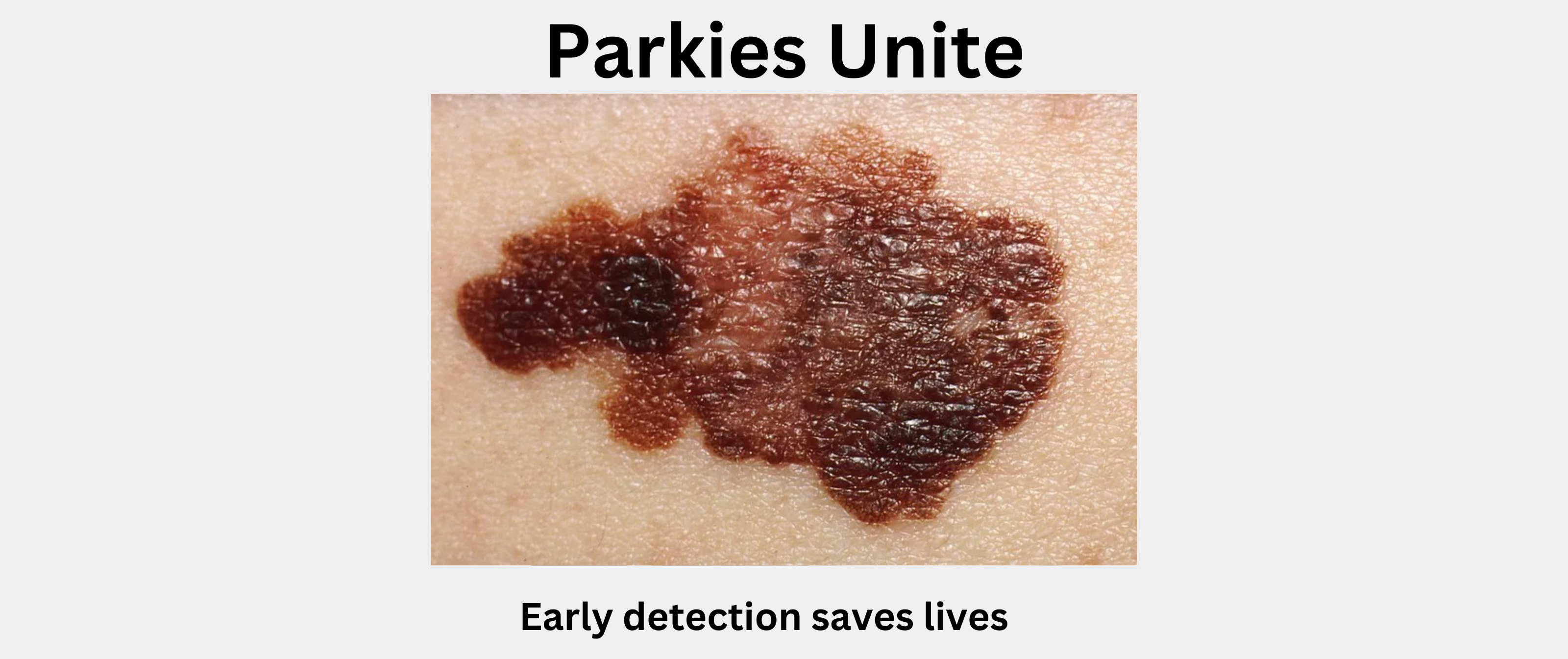Parkinson’s and Melanoma: A Hidden Connection

Parkinson’s disease (PD) and melanoma share a surprising and complex relationship that has intrigued researchers for decades. Studies indicate that people with Parkinson’s have a higher risk of developing melanoma, and vice versa. Understanding this link is critical for early detection and prevention, especially for those navigating life with PD.
The Hidden Link Between Parkinson’s and Melanoma
1. A Two-Way Relationship
- People with Parkinson’s disease have a 1.5 to 4 times higher risk of developing melanoma compared to the general population.
- Individuals diagnosed with melanoma are also more likely to develop Parkinson’s disease.
- The connection persists even when controlling for age, genetics, and environmental factors.
2. Genetic and Biological Overlaps
- Melanin & Neuromelanin: Melanin, the pigment in the skin, is structurally similar to neuromelanin found in the brain’s substantia nigra, the area most affected in PD.
- LRRK2 Gene Mutation: One of the most common genetic risk factors for Parkinson’s, LRRK2, has also been associated with melanoma.
- PINK1 and Parkin Genes: These genes, linked to mitochondrial dysfunction in PD, have also been implicated in melanoma development.
3. Dopamine’s Role in the Connection
- Dopamine and Melanocytes: Dopamine plays a role in melanocyte function, which may explain melanoma’s increased risk in PD patients.
- Levodopa Debate: Early concerns suggested levodopa (a common PD medication) might increase melanoma risk, but newer research does not support a direct causal link.
4. Immune System & Inflammation: The Common Thread
- Chronic Inflammation: Both PD and melanoma involve immune system dysfunction and chronic inflammation.
- Oxidative Stress: This is heavily involved in Parkinson’s disease and may also influence melanoma progression.
5. Environmental and Lifestyle Factors
- UV Exposure: While excessive sun exposure is a key melanoma risk factor, Parkinson’s patients are not necessarily more exposed to UV radiation.
- Pesticides & Toxins: Certain environmental toxins linked to Parkinson’s, such as pesticides, may also increase the risk of melanoma.
6. Recognizing Melanoma Symptoms with the ABCDE Rule
- A = Asymmetry: One half of the mole or growth differs from the other.
- B = Border: Irregular, jagged, or blurry edges.
- C = Color: Multiple colors within a single lesion, including brown, black, red, white, or blue.
- D = Diameter: Larger than 6mm or growing over time.
- E = Evolving: Changes in size, shape, texture, or color.
7. Types of Melanoma & Their Symptoms
- Superficial Spreading Melanoma: The most common form, accounting for 75% of all melanomas. It often appears as an irregular, multicolored patch on sun-exposed skin.
- Nodular Melanoma: Second most common type, making up 15-30% of cases. Often a fast-growing, dark, raised spot that may not fit the ABCDE rule.
- Lentigo Maligna Melanoma: Accounts for 5-15% of melanomas, usually appearing on the face or sun-damaged skin, growing gradually over time.
- Acral Lentiginous Melanoma: Found on palms, soles, or under nails, more common in darker skin tones.
- Rare Melanoma Types:
- Amelanotic melanoma: Lacks pigment, making it harder to diagnose.
- Desmoplastic melanoma: Resembles scar tissue and grows slowly.
- Mucosal melanoma: Appears in mucus membranes (mouth, vagina, gastrointestinal tract).
- Uveal melanoma: Affects the eyes.
8. Melanoma Symptoms in Children
- Rare but serious: Only 1% of all melanoma cases occur in individuals under 20.
- May not follow ABCDE criteria: Pediatric melanomas can be misdiagnosed, leading to delayed treatment.
- High-risk groups: Children with many moles or large birth moles require close monitoring.
9. Who is Most at Risk?
- Gender Differences:
- Under 50: Higher melanoma rates in women.
- Over 50: Higher rates and higher mortality in men.
- Race & Skin Tone:
- White individuals have 20 times the risk of melanoma compared to Black individuals.
- However, people of color are more likely to receive late-stage diagnoses, leading to higher mortality rates.
10. Prevention & Early Detection Strategies
- Regular Skin Exams: PD patients should have routine dermatological screenings.
- Track Changes: Take photos of your skin and use a body mole map.
- Annual Checkups: A full-body skin exam with a dermatologist can lead to early detection.
11. Questions to Ask Your Doctor
If you notice a new or changing mole, ask your healthcare provider:
- How can I tell the difference between a normal mole and melanoma?
- What diagnostic tests will be performed?
- Should I get a biopsy?
- Will I need to see a dermatologist or oncologist?
Conclusion
The Parkinson’s-melanoma connection is more than a statistical coincidence. It underscores shared genetic, biological, and environmental risk factors. Understanding this relationship enables early detection, prevention, and proactive management for individuals navigating life with Parkinson’s disease.
Generative AI Image Prompt:
“A highly detailed, photorealistic image of a human arm with a close-up of a melanoma lesion. The lesion follows the ABCDE melanoma criteria, appearing as an irregular, asymmetrical mole with jagged borders and multiple colors, including dark brown, black, and reddish hues. The image is well-lit with a medical examination room background, emphasizing clinical detail. The skin texture is realistic, showing natural pores and slight imperfections to enhance authenticity.”
Taglines:
- “Parkinson’s and melanoma: Know the risks.”
- “Early detection saves lives.”
- “Understanding the Parkinson’s-melanoma link.”
Negative Prompt:
“Malformed limbs, extra limbs, mutated hands, disfigured face, bad anatomy, malformed hands, text, lettering, captions, generating images with text overlays.”
AI-generated medical infographics on Parkinson’s symptoms, treatment advances, and research findings; I hope you found this blog post informative and interesting. www.parkiesunite.com by Parkie.
SEO Keywords: Parkinson’s disease, melanoma risk, skin cancer detection, genetic Parkinson’s link, early melanoma signs